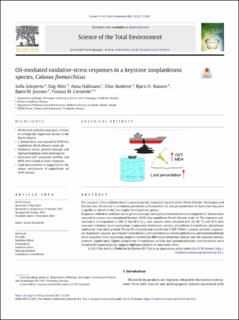| dc.contributor.author | Soloperto, Sofia | |
| dc.contributor.author | Altin, Dag | |
| dc.contributor.author | Hallman, Anna | |
| dc.contributor.author | Skottene, Elise | |
| dc.contributor.author | Hansen, Bjørn Henrik | |
| dc.contributor.author | Jenssen, Bjørn Munro | |
| dc.contributor.author | Ciesielski, Tomasz Maciej | |
| dc.date.accessioned | 2022-06-16T13:27:47Z | |
| dc.date.available | 2022-06-16T13:27:47Z | |
| dc.date.created | 2021-11-22T13:48:44Z | |
| dc.date.issued | 2022 | |
| dc.identifier.citation | Science of the Total Environment. 2022, 806 (4), 9. | en_US |
| dc.identifier.issn | 0048-9697 | |
| dc.identifier.uri | https://hdl.handle.net/11250/2999087 | |
| dc.description.abstract | The copepod Calanus finmarchicus is an ecologically important species in the North Atlantic, Norwegian and Barents seas. Accidental or continuous petroleum pollution from oil and gas production in these seas may pose a significant threat to this low trophic level keystone species. Responses related to oxidative stress, protein damage and lipid peroxidation were investigated in C. finmarchicus exposed to a water-accommodated fraction (WAF) of a naphthenic North Atlantic crude oil. The exposure concentration corresponded to 50% of the 96 h LC50, and samples were obtained at 0, 24, 48, 72 and 96 h after exposure initiation. Gene expressions (superoxide dismutase, catalase, glutathione S-transferase, glutathione synthetase, heat shock protein 70 and 90, ubiquitin and cytochrome P-450 330A1), enzyme activities (superoxide dismutase, catalase, glutathione S-transferase) and concentrations of total glutathione and malondialdehyde were analyzed. Gene expression analyses showed no differences between controls and the exposed animals, however significantly higher glutathione S-transferase activity and malondialdehyde concentrations were found in the exposed group, suggests lipid peroxidation as main toxic effect. | en_US |
| dc.language.iso | eng | en_US |
| dc.publisher | Elsevier | en_US |
| dc.rights | Navngivelse 4.0 Internasjonal | * |
| dc.rights.uri | http://creativecommons.org/licenses/by/4.0/deed.no | * |
| dc.subject | Glutathione S-transferase | en_US |
| dc.subject | Malondialdehyde | en_US |
| dc.subject | Oxidative stress | en_US |
| dc.subject | Zooplankton | en_US |
| dc.subject | Sublethal effects | en_US |
| dc.subject | Oil spills | en_US |
| dc.title | Oil-mediated oxidative-stress responses in a keystone zooplanktonic species, Calanus finmarchicus | en_US |
| dc.title.alternative | Oil-mediated oxidative-stress responses in a keystone zooplanktonic species, Calanus finmarchicus | en_US |
| dc.type | Peer reviewed | en_US |
| dc.type | Journal article | en_US |
| dc.description.version | publishedVersion | en_US |
| dc.rights.holder | © 2021 The Authors. Published by Elsevier B.V. | en_US |
| dc.source.pagenumber | 9 | en_US |
| dc.source.volume | 806 | en_US |
| dc.source.journal | Science of the Total Environment | en_US |
| dc.source.issue | 4 | en_US |
| dc.identifier.doi | 10.1016/j.scitotenv.2021.151365 | |
| dc.identifier.cristin | 1957329 | |
| dc.relation.project | EC/H2020/679266 | en_US |
| dc.source.articlenumber | 151365 | en_US |
| cristin.ispublished | true | |
| cristin.fulltext | original | |
| cristin.qualitycode | 2 | |

